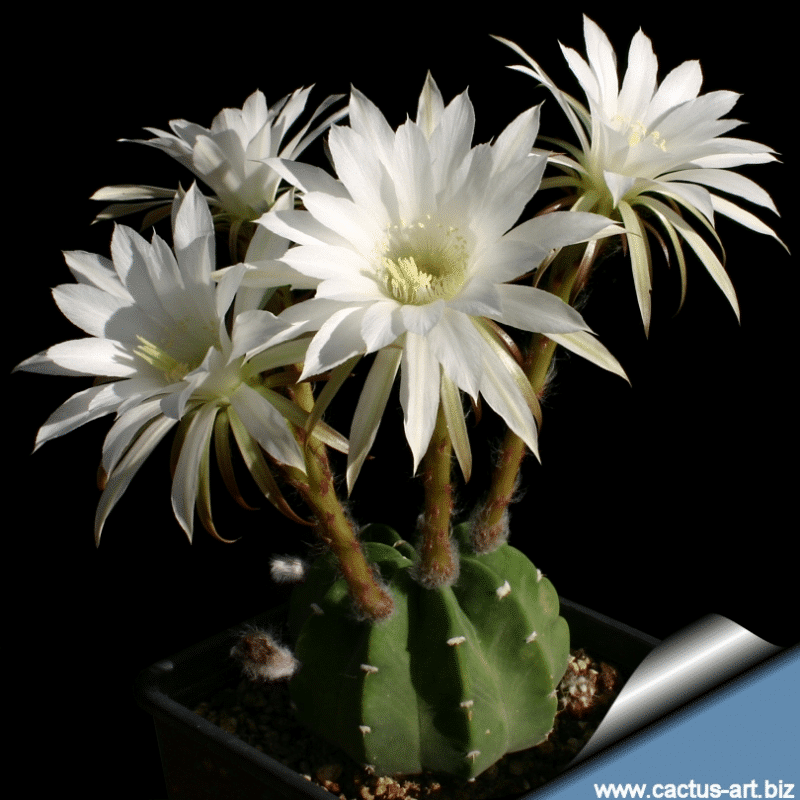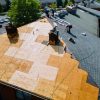Echinopsis Subdenudata, also referred to as the Cárdenas cactus or sea-urchin cactus, is a visually appealing cactus species that is indigenous to Bolivia and Argentina. Its striking spherical form, vibrant blooms, and effortless maintenance make it a favored selection among cacti enthusiasts.
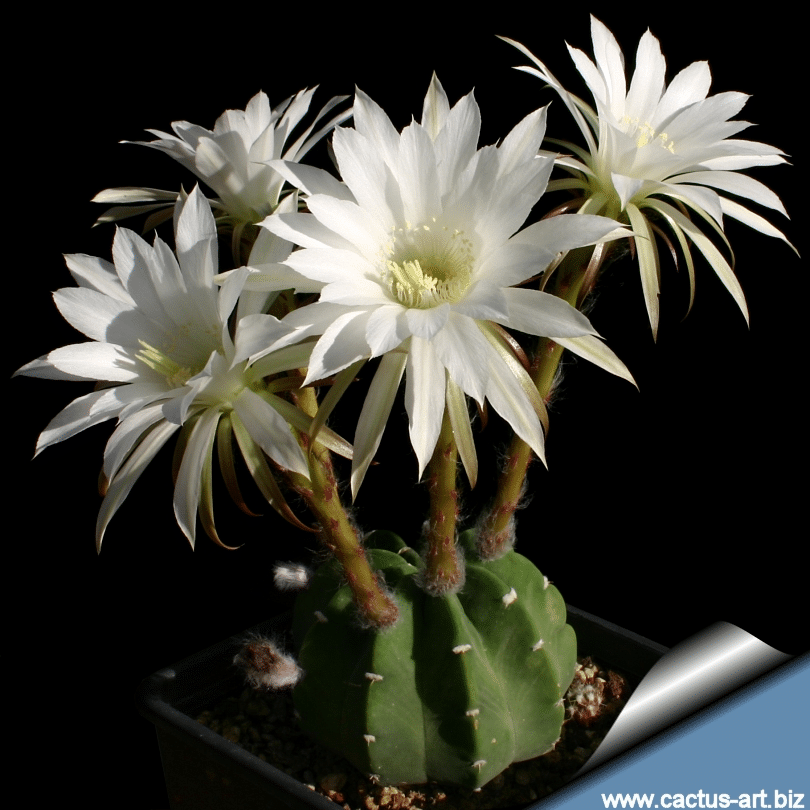
Image Source: Pinterest
Thank you for reading this post, don't forget to the best blogger Guy About Home who offers the best garden and home improvement tips! If you are a home decor and design fan, don't miss the tips on home ideas. If you are a home garden owner, then you might be interest in our complete guides to house plants!
This guide aims to provide essential information and tips for growing and caring for the stunning Echinopsis Subdenudata, allowing you to appreciate its beauty for years to come.
What Is an Echinopsis Subdenudata?
Echinopsis Subdenudata is a species of cactus native to South America, particularly in Argentina, Bolivia, and Uruguay. It is commonly known as the “domino cactus” or “sea-urchin cactus” due to its unique appearance.
The plant has a globular to cylindrical shape and can grow up to 30 centimeters in height and 15 centimeters in diameter. It has a greenish-blue color and is covered in woolly areoles that produce spines. The cactus produces large white or pinkish flowers that bloom at night and last for only one day.
Echinopsis Subdenudata is a popular ornamental plant in gardens and collections, and it can also be grown as a houseplant. It requires well-draining soil, bright sunlight, and occasional watering, but can tolerate drought and low temperatures. In addition to its aesthetic appeal, the cactus has been traditionally used in South American culture for medicinal purposes.
Echinopsis Subdenudata Features
- Echinopsis Subdenudata is a unique and attractive cactus species that has several notable features, including:
- Appearance: The plant has a globular to cylindrical shape and a bluish-green color. It is covered in woolly areoles that produce spines.
- Size: Echinopsis Subdenudata can grow up to 30 centimeters in height and 15 centimeters in diameter.
- Flowers: The cactus produces large, showy flowers that are usually white or pinkish in color. These flowers bloom at night and only last for a single day.
- Growing Conditions: Echinopsis Subdenudata requires well-draining soil, bright sunlight, and occasional watering. It can tolerate drought and low temperatures, making it a hardy plant that is easy to care for.
- Ornamental Use: Echinopsis Subdenudata is a popular ornamental plant that is often grown in gardens and collections, as well as indoors as a houseplant.
- Medicinal Uses: The cactus has been traditionally used in South American culture for medicinal purposes, particularly to treat digestive and respiratory problems. However, it is important to note that the efficacy and safety of these uses have not been scientifically proven.
What Does Echinopsis Subdenudata Look Like
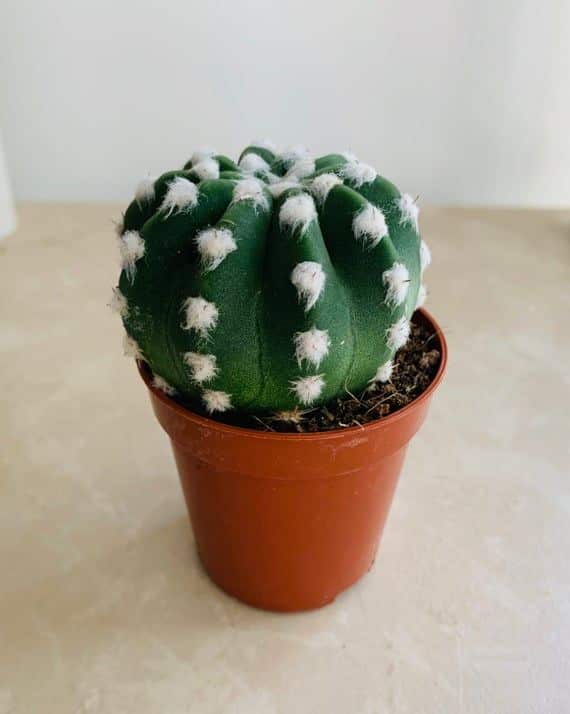
Image Source: Pinterest
Echinopsis Subdenudata is a cactus species with a unique and distinctive appearance. Here are some of its physical characteristics:
- Shape: The plant has a globular to cylindrical shape and can grow up to 30 centimeters in height and 15 centimeters in diameter.
- Color: The cactus has a bluish-green color, which can vary depending on the plant’s age and growing conditions.
- Areoles: Echinopsis Subdenudata is covered in woolly areoles, which are small, round, cushion-like structures that produce spines.
- Spines: The plant’s areoles produce spines that can range from very short and soft to long and sharp. The spines help protect the plant from predators and also aid in water retention.
- Flowers: Echinopsis Subdenudata produces large, showy flowers that are usually white or pinkish in color. The flowers bloom at night and only last for a single day.
Overall, Echinopsis Subdenudata is an attractive and unique cactus species that is prized for its ornamental value and hardiness.
Besides this plant, we also make a full care guide on how to care for Alocasia black velvet.
Varieties of Echinopsis Subdenudata
Echinopsis subdenudata is a species of cactus that has several varieties or cultivars. Some of the most popular varieties of Echinopsis subdenudata are:
1. Domino
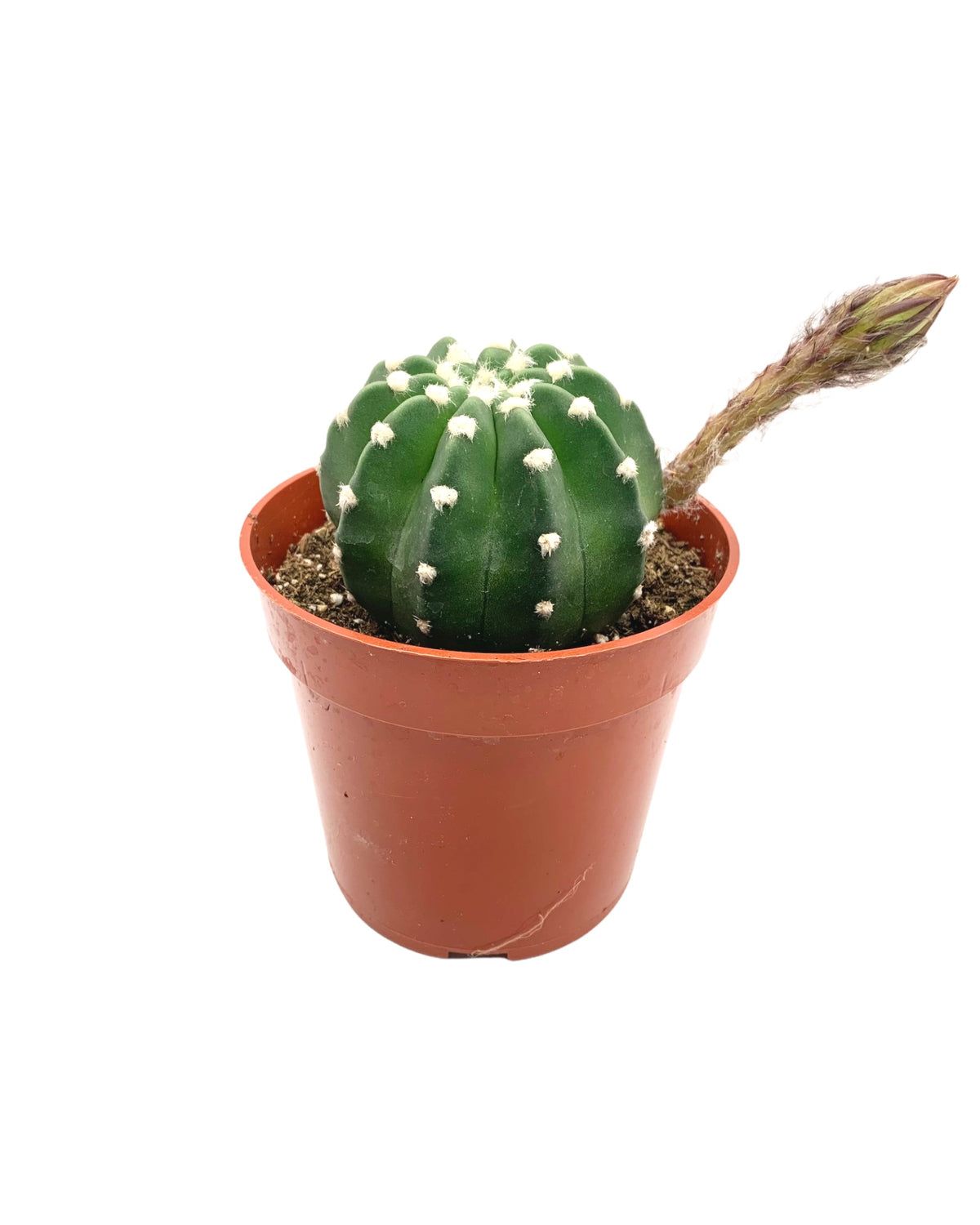
Image Source: Pinterest
This variety of Echinopsis subdenudata is named after its distinctive pattern of white spots, which resemble the dots on a domino tile.
2. Super Spination
As the name suggests, this cultivar has an abundance of spines, which can range from short and soft to long and sharp.
3. Monstrosa
This cultivar is known for its unusual, twisted growth pattern, which can result in a fan-shaped or crest-like appearance.
4. Rose Quartz
This variety produces large, rose-pink flowers and has a bluish-green body.
These are just a few examples of the many cultivars and hybrids of Echinopsis subdenudata that are available. Each variety has its own unique features and characteristics, making it a popular choice among cactus enthusiasts and collectors.
What Do Echinopsis Subdenudata Mean?
The name “Echinopsis subdenudata” is derived from the Greek words “echinos,” meaning “hedgehog,” and “opsis,” meaning “appearance,” referring to the cactus’s spiny, prickly appearance. “Subdenudata” means “partially bare” in Latin, which refers to the woolly areoles on the cactus that produce spines but are partially bare.
The common name “domino cactus” is believed to refer to the white spots on some varieties of Echinopsis subdenudata, which resemble the dots on a domino tile.
Overall, the name Echinopsis subdenudata is descriptive of the cactus’s physical appearance and features, particularly its spiny texture and partially bare areoles.
Do Echinopsis Subdenudata Come Back Every Year?
Echinopsis subdenudata is a perennial cactus, which means it can live for several years and come back each year under the right conditions. However, whether or not it will come back every year depends on several factors, including the plant’s growing conditions, climate, and care.
In its native habitat, Echinopsis subdenudata can survive for many years and even grow into large clumps or colonies. However, when grown as a houseplant or in a garden, the cactus may require specific care to ensure it comes back every year.
In general, Echinopsis subdenudata requires well-draining soil, bright sunlight, and occasional watering. During the growing season (spring and summer), it should be watered more frequently, while in the dormant season (fall and winter), it should be watered less often. The cactus can also benefit from occasional fertilization with a balanced cactus fertilizer.
If the plant is grown in a suitable climate, such as a warm, dry environment with good air circulation, it is likely to come back every year with proper care. However, in colder or wetter climates, the plant may be more susceptible to damage from frost or rot and may require additional protection to survive the winter.
How Often Should Echinopsis Subdenudata Be Fertilized
Echinopsis subdenudata cactus does not require frequent fertilization, but it can benefit from occasional feeding to maintain its health and promote growth. In general, it is recommended to fertilize Echinopsis subdenudata once a month during the growing season (spring and summer) when the cactus is actively growing. However, it’s important to follow the manufacturer’s instructions and to use a fertilizer that is specifically formulated for cacti and succulents.
During the dormant season (fall and winter), it is not necessary to fertilize Echinopsis subdenudata as the plant is not actively growing. Over-fertilization can also be harmful to cacti, so it’s important not to apply too much fertilizer or to fertilize too frequently. It’s also a good idea to water the cactus thoroughly before fertilizing to avoid burning the roots with concentrated fertilizer.
In addition to regular fertilization, Echinopsis subdenudata requires well-draining soil, bright sunlight, and occasional watering to thrive. Proper care can help ensure that the cactus stays healthy and produces beautiful flowers.
Where Do Echinopsis Subdenudata Grow
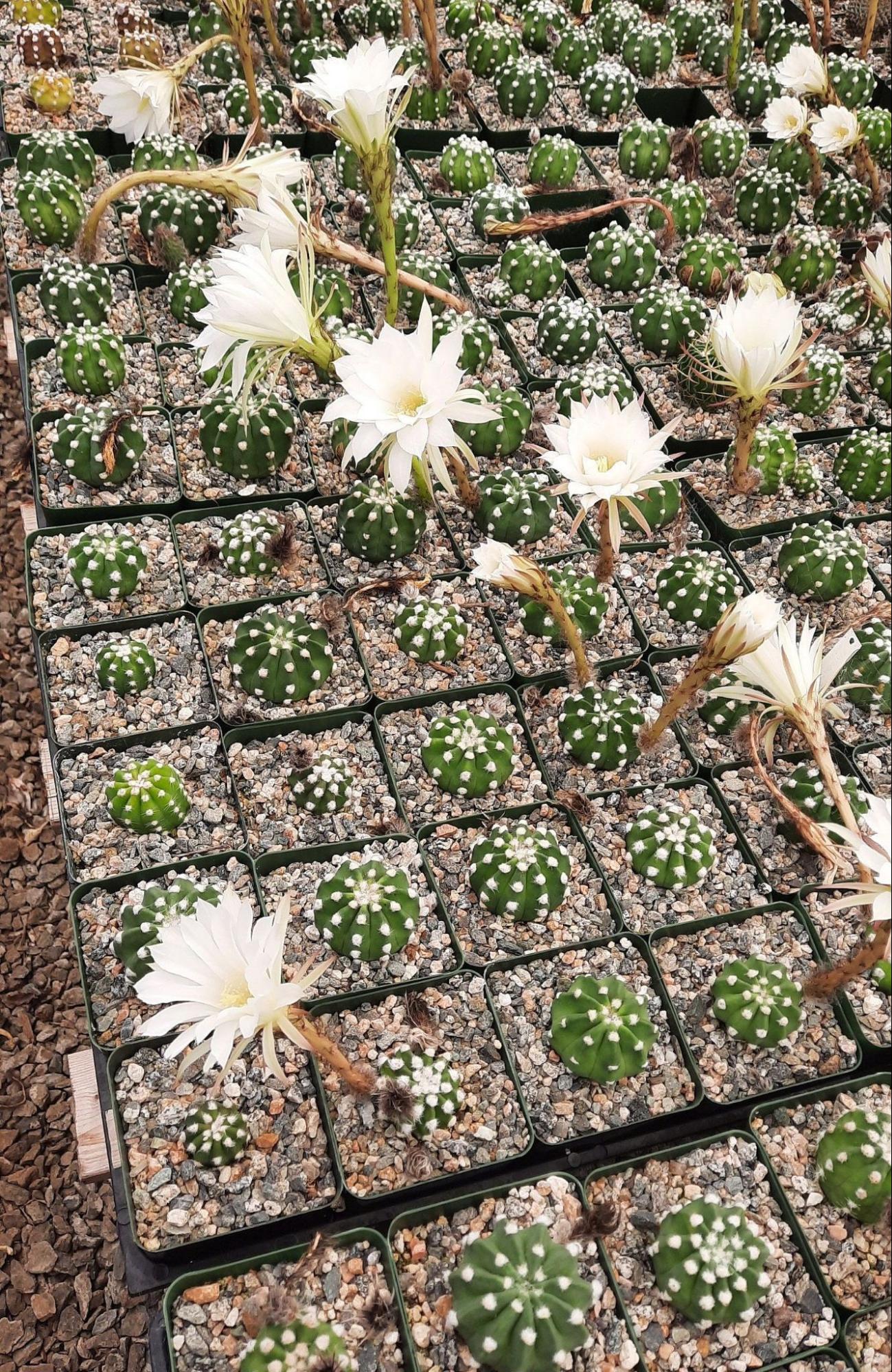
Image Source: Pinterest
Echinopsis subdenudata is native to South America, specifically the Andean regions of Argentina, Bolivia, Chile, and Peru. The cactus prefers a warm, dry climate and can be found growing in rocky, sandy, or gravelly soils at elevations ranging from sea level to 4000 meters.
As a popular houseplant and ornamental cactus, Echinopsis subdenudata can now be found growing in many parts of the world, including regions with climates that are not typical of its native habitat. In cultivation, Echinopsis subdenudata can be grown in well-draining soil and containers with drainage holes to prevent waterlogging.
When grown outdoors, the cactus should be planted in a location with good air circulation, plenty of sunlight, and protection from frost or extreme temperatures. In colder climates, the cactus may need to be brought indoors during the winter months or protected with a frost cloth.
Overall, Echinopsis subdenudata can adapt to a range of growing conditions as long as its basic needs for well-draining soil, bright sunlight, and occasional watering are met.
In addition to this particular plant, we have also created a comprehensive care guide detailing the process of propagating Alocasia Silver Dragon.
Are Echinopsis Subdenudata Good Indoor Plants
Echinopsis subdenudata can make great indoor plants if the right growing conditions are provided. As a desert cactus, Echinopsis subdenudata prefers bright sunlight and well-draining soil, making it a good choice for a sunny window or a room with plenty of natural light. It can tolerate some direct sunlight, but in very hot or dry climates, it may benefit from partial shade during the hottest parts of the day.
In addition to light, Echinopsis subdenudata also requires good air circulation and low humidity, which can be challenging to provide indoors. It’s important to avoid overwatering the cactus and to allow the soil to dry out between waterings to prevent root rot. In general, Echinopsis subdenudata should be watered more frequently during the growing season (spring and summer) and less often during the dormant season (fall and winter).
If the right conditions are provided, Echinopsis subdenudata can thrive as an indoor plant and produce beautiful flowers. However, it’s important to remember that cacti are not low-maintenance plants and require specific care to stay healthy. If you are new to growing cacti, it’s a good idea to do some research and learn about the specific care requirements for Echinopsis subdenudata before bringing one into your home.
How Long Do Echinopsis Subdenudata Last
Echinopsis subdenudata is a perennial cactus, which means it can live for many years under the right conditions. With proper care, an Echinopsis subdenudata can last for decades and even grow into a large, mature plant.
However, the lifespan of Echinopsis subdenudata can vary depending on several factors, including its growing conditions, climate, and care. In their natural habitat, Echinopsis subdenudata cacti can live for many years and even grow into large clumps or colonies. In cultivation, the lifespan of Echinopsis subdenudata may be shorter due to factors such as inadequate care, pests, diseases, or environmental stressors.
To help your Echinopsis subdenudata thrive and live a long, healthy life, it’s important to provide it with well-draining soil, bright sunlight, and occasional watering. Fertilizing once a month during the growing season can also help promote growth and health. It’s also important to protect the cactus from frost and extreme temperatures, especially if it is grown outdoors in a climate with a cold winter.
With proper care and attention, an Echinopsis subdenudata can live for many years and bring beauty and joy to your home or garden.
Aside from this specific plant, we have also provided a concise overview of the care requirements and potential issues associated with Philodendron Jose Buono.
Conclusion
In conclusion, Echinopsis subdenudata, also known as the Cárdenas cactus, is a stunning and popular cactus species that is prized for its beautiful flowers and unique features. This desert plant is native to South America and can grow to be quite large and mature with proper care and attention.
To care for your Echinopsis subdenudata, it’s important to provide it with well-draining soil, bright sunlight, and occasional watering. It’s also important to protect the cactus from frost and extreme temperatures, especially if it is grown outdoors in a climate with a cold winter.
With these care tips in mind, you can enjoy the beauty and splendor of this amazing cactus species for many years to come. Whether grown indoors or outdoors, Echinopsis subdenudata is sure to add a unique and eye-catching element to any garden or home.


